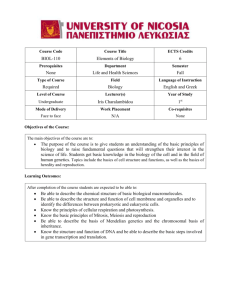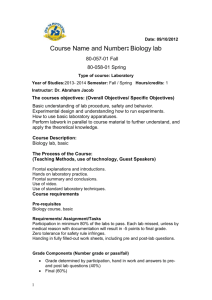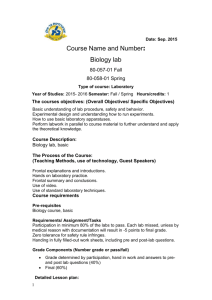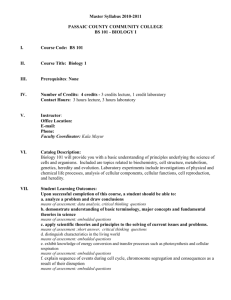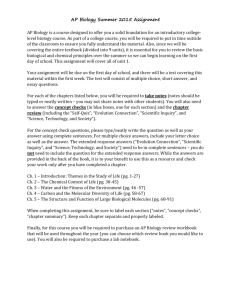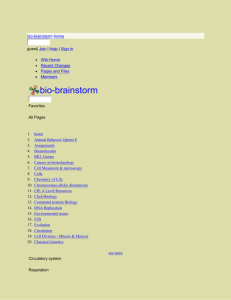Document
advertisement
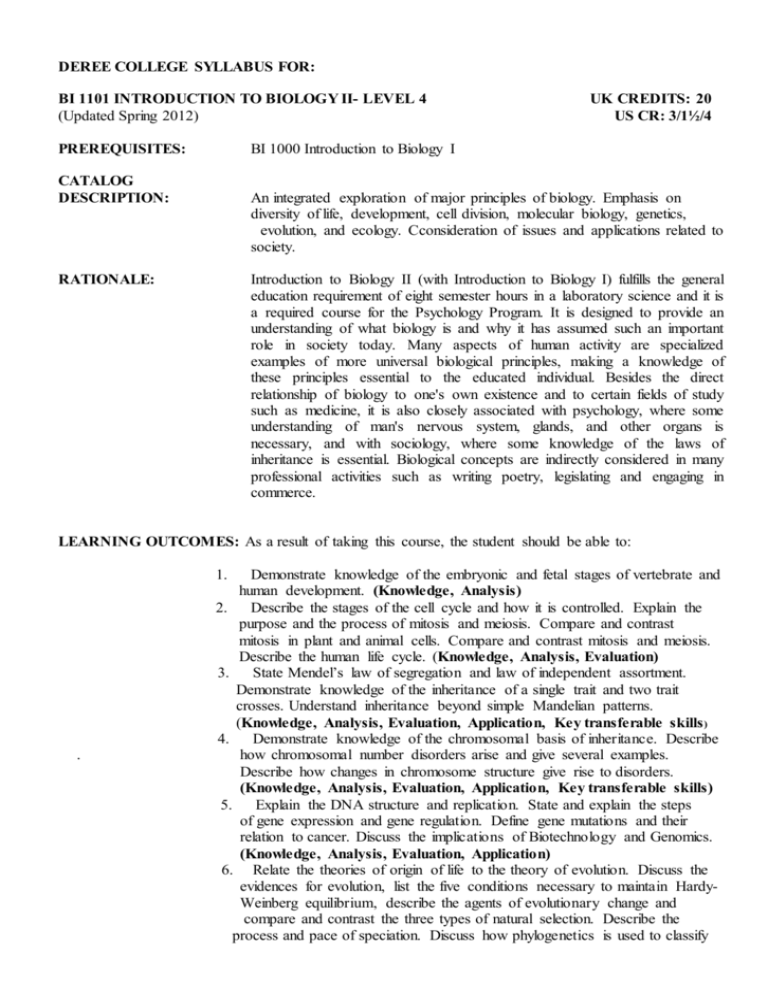
DEREE COLLEGE SYLLABUS FOR: BI 1101 INTRODUCTION TO BIOLOGY II- LEVEL 4 (Updated Spring 2012) PREREQUISITES: UK CREDITS: 20 US CR: 3/1½/4 BI 1000 Introduction to Biology I CATALOG DESCRIPTION: An integrated exploration of major principles of biology. Emphasis on diversity of life, development, cell division, molecular biology, genetics, evolution, and ecology. Cconsideration of issues and applications related to society. RATIONALE: Introduction to Biology II (with Introduction to Biology I) fulfills the general education requirement of eight semester hours in a laboratory science and it is a required course for the Psychology Program. It is designed to provide an understanding of what biology is and why it has assumed such an important role in society today. Many aspects of human activity are specialized examples of more universal biological principles, making a knowledge of these principles essential to the educated individual. Besides the direct relationship of biology to one's own existence and to certain fields of study such as medicine, it is also closely associated with psychology, where some understanding of man's nervous system, glands, and other organs is necessary, and with sociology, where some knowledge of the laws of inheritance is essential. Biological concepts are indirectly considered in many professional activities such as writing poetry, legislating and engaging in commerce. LEARNING OUTCOMES: As a result of taking this course, the student should be able to: 1. . Demonstrate knowledge of the embryonic and fetal stages of vertebrate and human development. (Knowledge, Analysis) 2. Describe the stages of the cell cycle and how it is controlled. Explain the purpose and the process of mitosis and meiosis. Compare and contrast mitosis in plant and animal cells. Compare and contrast mitosis and meiosis. Describe the human life cycle. (Knowledge, Analysis, Evaluation) 3. State Mendel’s law of segregation and law of independent assortment. Demonstrate knowledge of the inheritance of a single trait and two trait crosses. Understand inheritance beyond simple Mandelian patterns. (Knowledge, Analysis, Evaluation, Application, Key transferable skills ) 4. Demonstrate knowledge of the chromosomal basis of inheritance. Describe how chromosomal number disorders arise and give several examples. Describe how changes in chromosome structure give rise to disorders. (Knowledge, Analysis, Evaluation, Application, Key transferable skills) 5. Explain the DNA structure and replication. State and explain the steps of gene expression and gene regulation. Define gene mutations and their relation to cancer. Discuss the implications of Biotechnology and Genomics. (Knowledge, Analysis, Evaluation, Application) 6. Relate the theories of origin of life to the theory of evolution. Discuss the evidences for evolution, list the five conditions necessary to maintain HardyWeinberg equilibrium, describe the agents of evolutionary change and compare and contrast the three types of natural selection. Describe the process and pace of speciation. Discuss how phylogenetics is used to classify 2 BI 1101 organisms. (Knowledge, Analysis, Evaluation, Application) Classify and characterize the major phyla of organisms in the five kingdoms. Evaluate the interactions of organisms in ecosystems, the energy flow, the chemical cycling, the nature of biomes and aquatic communities, the human population concerns and the human impact on ecosystems (Knowledge, Analysis, Evaluation, Application) 8. Develop the necessary analytical tools to understand the nature of scientific inquiry by practicing inquiry in the laboratory and by addressing the right questions and applying the appropriate methodology. (Key transferable skills, Practical skills) 7. METHOD OF TEACHING AND LEARNING: In congruence with the learning and teaching strategy of the college, the following tools are used: Ø Class lectures, interactive learning (class discussions, group work) video presentations, and practical problems solved in class. Ø Exercises and primary source documents are assigned as homework, the solutions of which are reviewed in class Ø Laboratory work (some laboratory reports and drawings may be required). Ø CD-ROMS (The Dynamic Human, Explorations in Human Biology. Virtual Biology Laboratory, Explorations in Cell Biology & Genetics). Ø Inquiry Into Life Web site. www.mhhe.com/maderinquiry13 http://highered.mcgrawhill.com/sites/007340344x/information_center_view0/ Ø Office hours: students are encouraged to make full use of the office hours of their instructor, where they can ask questions, see their exam paper, and/or go over lecture/lab material. Ø Use of a blackboard site, where instructors post lecture notes, assignment instructions, timely announcements, as well as additional resources. ASSESSMENT: Multiple "diagnostic" tests – formative (on-line) 0 In-class lab Midterm (1/2-hour)- 10 In-class midterm examination (2-hour) 30 Subtotal for MID I summative 40 In-class lab Final Exam (1/2-hour) 10 Final examination (2-hour) 50 Subtotal for Final Exam--summative 60 Total of all Exams 100 Multiple choice/short answers/ /essay questions combination Microscopy slide identification, diagram labelling, organ identification, problem solving , short answers, classification of organisms, chemical reactions of processes etc Multiple choice/short answers/matching /essay questions combination/problem solving Microscopy slide identification, diagram labelling, organ identification, problem solving , short answers, classification of organisms, chemical reactions of processes etc Multiple choice/short answers/matching/ /essay questions combination/problem solving The formative on-line tests aim to prepare students for the examinations. Students are expected to submit feedback on their performance. The two lab exams test the practical component of all learning outcomes of the course as stated in learning outcome 8. The midterm examination tests Learning Outcomes 1-5 The final examination tests Learning Outcome 6 and 7 3 BI 1101 READING LIST: Required Textbook: Required Lab Manual: SOFTWARE REQUIREMENTS: Mader, Sylvia S. Inquiry Into Life; McGraw-Hill Higher Education, latest ed Mader, Sylvia S. Inquiry Into Life; Lab Manual; McGraw-Hill Higher Education, latest edition. Microsoft Word, Microsoft PowerPoint, Blackboard CMS. WWW RESOURCES: http://www.mhhe.com/maderinquiry13 http://www.dnalc.org http://www.medtropolis.com/VBody.asp http://www.whitman.edu/biology/vpd/ http://www.cellsalive.com/ http://tolweb.org/tree/ http://multimedia.mcb.harvard.edu/media.html http://www.mcb.harvard.edu/BioLinks.html http://www.mhhe.com/biosci/esp/2002_general/Esp/default.htm http://nhscience.lonestar.edu/biol/bio1int.htm http://biology.uco.edu/AnimalBiology/Tissues/Tissuhome.html http://www.sciam.com http://www.maxanim.com/genetics/cDNA/cDNA.htm INDICATIVE CONTENT: 1. Embryology and Development 1.1. Cleavage, differentiation, and morphogenesis 1.2. Embryonic membranes 1.3. Birth and circulation changes, etc. 2. Reproduction: Cellular Aspects (mitosis and meiosis) 3. Genetics 3.1. The chromosome theory of heredity 3.2. Genes and their action – Biotechnology 4. The History of Life 4.1. Geological time scale and historical record 4.2. The origin of life 4.3. Fossils 5. Evolution 5.1. History and Darwin 5.2. Genetics of populations and natural selection 5.3. Variation, species, and speciation 6. The Diversity of Life 6.1. Principles of classification 6.2. Monera, viruses, protista and fungi 6.3. Major groups of animals (basic features and relationships) 6.4. Major groups of plants (basic features and relationships) 7. Ecology 7.1. Environment (physical and biotic) 7.2. Cycles of materials and transfers of energy 7.3. Interactions between species 7.4. Succession, and limiting and balancing factors 7.5. Biomes 8. The Geography of Life 8.1. Terrestrial communities 4 BI 1101 8.2. Ecological and historical biogeography 9. Population Ecology Note: Some consideration is given to a few of the biological problems of society as they relate to the above topics. LAB OUTLINE: WEEK 1ST Laboratory Safety. Rules and Regulations. Early Starfish and Human Development WEEK 2ND Cellular Details of Reproduction: Mitosis and Meiosis WEEK 3RD Basic Principles of Heredity WEEK 4T H Human Genetics WEEK 5T H DNA Biology and Technology WEEK 6T H LAB EXAM I; Monera, Protista, Fungi WEEK 7T H Seedless Plants WEEK 8T H Seed Plants WEEK 9T H Sponges, Cnidaria, Flatworms, Roundworms, Annelida WEEK 10T H Mollusks, Anthropods WEEK 11T H Echinodermata, Chordata WEEK 12T H Fossils, Symbiotic Relationships WEEK 13T H LAB EXAM II; Effects of Pollution on Ecosystems WEEK 14T H STUDENT FEEDBACK ON FINAL LAB EXAM DURING THE END OF COURSE FINAL EXAM
